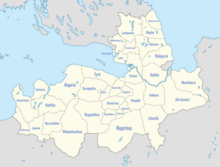
Back Ingermanland Afrikaans Ingermanland ANG إنغيريا Arabic انجيريا ARZ Ėngrėjė BAT-SMG Інгерманландыя Byelorussian Іжора BE-X-OLD Ingria Breton Íngria Catalan Ingrie Czech
You can help expand this article with text translated from the corresponding article in Russian. (January 2021) Click [show] for important translation instructions.
|
| Ingria Izhora | |
|---|---|
| Historical region | |
 | |
| Demonym | |
| Area | |
| • Coordinates | 59°38′N 29°18′E / 59.633°N 29.300°E |
| Today part of | |
Ingria (Russian: Ингрия, Ингерманландия, Ижорская земля, romanized: Ingriya, Ingermanlandiya, Izhorskaya zemlya; Finnish: Inkeri, Inkerinmaa; Swedish: Ingermanland; Estonian: Ingeri, Ingerimaa) is a historical region in what is now northwestern European Russia. It lies along the southeastern shore of the Gulf of Finland, bordered by Lake Ladoga on the Karelian Isthmus in the north and by the River Narva on the border with Estonia in the west. The earliest known modern inhabitants of the region were indigenous Finnic ethnic groups, primarily the Izhorians and Votians, who were forcibly converted to Eastern Orthodoxy over several centuries during the late Middle Ages. They were later joined by the Ingrian Finns, descendants of 17th century Lutheran Finnish immigrants to the area. At that time, modern Finland proper and Ingria were both part of the Swedish Empire.
Ingria as a whole never formed a separate state; however, North Ingria was an independent state for just under two years in 1919–1920. The inhabitants of Ingria cannot be said to have comprised a distinct nation, since the population is made up of several different ethnic groups, despite the Soviet Union recognizing Ingrian as a nationality. The indigenous peoples of Ingria, like the Votians and Izhorians, are today close to extinction, together with their languages. This notwithstanding, many people still recognize and attempt to preserve their Ingrian heritage.[2]
Historic Ingria covers approximately the same area as the Gatchinsky, Kingiseppsky, Kirovsky, Lomonosovsky, Tosnensky, Volosovsky and Vsevolozhsky districts of modern Leningrad Oblast as well as the city of Saint Petersburg.
The names of the region are:
- Finnish: Inkeri or Inkerinmaa;
- Russian: Ингрия, Ingriya, Ижора, Izhora, or Ингерманландия, Ingermanlandiya;
- Swedish: Ingermanland;
- Estonian: Ingeri or Ingerimaa
- ^ Based on Räikkönen, Erkki. Heimokirja. Helsinki: Otava, 1924.
- ^ Kurs, Ott (1994). "Ingria: The broken landbridge between Estonia and Finland". GeoJournal 33.1, 107–113.

